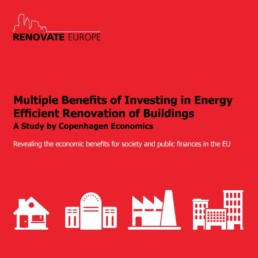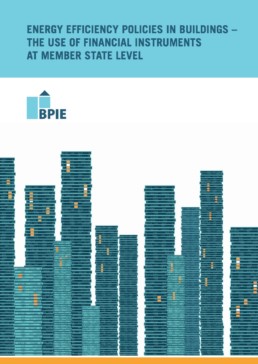Renovating Europe’s buildings could boost GDP by €291 billion by 2017
Investing in building renovation could accrue up to €175 billion per year for public finances with an additional “one-off” boost to GDP in the range of €153 to €291 billion for the years up to and including 2017. This is according to a new report prepared by Copenhagen Economics for the Renovate Europe Campaign.
The report which was launched at today’s Renovate Europe Day Conference2 , shows that when the challenge of renovating the EU building stock is taken up with a high level of ambition, permanent increases in revenue for public finances will result. The report also provides a number of policy recommendations for European governments to help boost public finances through renovation. These include shifting or reducing incentives such as favourable tax treatment of heating and electricity use in buildings to encourage a lower usage, thus rendering energy efficient renovation of buildings more attractive. Modernising rent regulation to allow landlords and tenants to share the gains from energy efficient renovations is another example.
Commenting on the report, , Adrian Joyce, Campaign Director of the Renovate Europe Campaign said “We know that many Member States are still hesitant about whether or not to invest in energy efficient building renovation programmes, despite the requirements of the recently adopted Energy Efficiency Directive3 . The findings in this new report will provide the final convincing arguments for those Member States, leading them to act. Investing in energy efficiency of buildings is a good investment in the short-term, the medium-term and the long-term.”
The second edition of Renovate Europe Day focuses on the theme of Stimulating Growth and Jobs in Europe.
In his address to the Conference, Günther Oettinger, EU Commissioner for Energy said “Energy efficiency is, for the European Union, the most direct and cost-effective way to achieve our strategic goals” and he goes on to elaborate on a number of key elements of EU Policy that go in this direction. He then turns to financing and informs the audience that: “…the European Union needs to focus and redirect its financial sources to address the energy efficiency financing challenge … That is why the Commission is keen to create the right conditions to bring more private sector financing into the energy efficiency market.”
The Renovate Europe Campaign is supported by 23 companies and associations.
IMPACT ON PUBLIC FINANCES
A STUDY BY COPENHAGEN ECONOMICS
Released at Renovate Europe Day, 11 October 2012
The Renovate Europe Campaign reached out to 28 Finance Ministers to highlight the Multiple Benefits of Investing in Energy Efficient Renovations as outlined in this Report.
Download the Key Messages Brochure
Download the Full Report and Appendix
Energy Efficiency Policies in Buildings - the Use of Financial Instruments at Member State Level
The BPIE report highlighted the complexity of the sector in large part because Member States had over decades separately developed their buildings sectors in terms of policies, design and construction techniques. The report showed a mosaic of building cultures and policies.
Policy-making cannot be undertaken effectively in a knowledge vacuum. With buildings representing about 40% of energy consumption and almost the same level of GHG emissions, there is a need for a strong analytical foundation for policy-making, particularly when there are priority policy concerns such as energy security and global climate change. Data and information are essential and the “Microscope” study started that data journey. The 2011 publication presented a fraction of the information and data collected. The database is now being used as an information pool to deepen the discussion in several key areas.
The 2011 report highlighted many of the market barriers that will impede such levels of energy performance improvements. The major set of barriers concerns the financing of such improvements. While the investments are considered cost-effective over the lifetime of the building, there are undoubtedly high up-front expenditures. The 2011 report gave some attention to the financial instruments available in Europe but, understandably, the review was only a first step.
This report takes a closer look at how financial instruments are currently being used in Europe and provides some evidence on their effectiveness. The focus is mainly on existing buildings, because these types of buildings represents the biggest potential for reducing GHG emission. New buildings only add about 1% per year to the total building stock. If buildings are to contribute their rightful share to the reduction of GHG emissions and energy savings by 2020 and 2050, the level of ambition must be high but must also be realistic, based on a strong analytical foundation. It is estimated that, on average, buildings can achieve 75-80% improvements in energy performance. What was once considered prohibitive is now widely accepted.
The Energy Efficiency Directive – Ready for Take-Off if Member States Act Decisively
Will the Energy Efficiency Directive, as agreed by the Member States, the European Parliament and the European Commission on the 13th June fly? It has elements in it that could, if properly and fully implemented at Member State level, see increased energy efficiency take-off, but its propositions on building renovations will not contribute as much as they could to the voluntary target of a 20% increase in energy efficiency by 2020!
For the existing EU building stock, the text is not as ambitious as it could have been as the Member States remain unconvinced about the huge social, environmental and economic benefits that building renovation programmes for each country can bring. The compromise reached on the renovation of public buildings (Article 4) limits required actions to central government buildings and thus to a tiny percentage of the overall building stock. In fact, the quantity of building included is so small that the market does not expect any stimulus effects to arise from this provision.
More promising is the inclusion (in a new Article 3a) of a requirement for each Member State to establish a long-term strategy for the renovation of the entire national building stock by April 2014. In this provision there is an opportunity for Member States to clear a path for a more prosperous, energy efficient and lowercarbon future as about 40% of all end-use energy is accounted for by buildings and about 32% of all carbon emission.
“To make the Directive fly and to ensure that it achieves the potential offered by the building stock of the EU, Member States will have to propose innovative, long-term, stable measures that take account of national conditions.” said Adrian Joyce, the Director of the Renovate Europe Campaign. “This can best be achieved by creating national building renovation roadmaps with a horizon of 2050 in which the goal is to reduce the energy demand of the EU building stock by 80% over current levels and the partners in the Renovate Europe Campaign are ready to assist in this endeavour.”
With a well-documented potential to create hundreds of thousands of long-term, stable, local jobs and with an average positive return on investment of over 12%, undertaking the extensive renovation of the EU building stock is a sure way to boost economic activity whilst also improving the built environment and hence the health of EU citizens.
Recognising the challenges ahead, Adrian Joyce adds: “Now that the text of the Directive is known, it’s time to roll up our sleeves, start work and get the buildings renovation sector off the ground!”
Renovate Europe issues concrete recommendations on financing energy efficiency
What are the challenges ahead for financing energy efficiency in the next Multi-Annual Financial Framework period? Which successful examples of financing instruments and partnership models can be promoted to encourage further investment in energy efficiency? Which initiatives need to be supported at the national and EU level to ensure that the potential of energy efficiency is transformed into real long-term economic benefits in the future?
Workshop on the Multi-Annual Financial Framework
Knowledge Building Workshop on the use of the MFF for Energy Efficient Investments in Buildings
 On the 22nd March 2012, the Renovate Europe Campaign organised in Brussels a high-level Workshop on the use of the MFF for energy efficient investment in buildings. The Workshop formed part of a series of events on financing energy efficiency in buildings that will take place in 2012.
On the 22nd March 2012, the Renovate Europe Campaign organised in Brussels a high-level Workshop on the use of the MFF for energy efficient investment in buildings. The Workshop formed part of a series of events on financing energy efficiency in buildings that will take place in 2012.
The Workshop was by invitation only ( see Agenda ) and approximately 60 experts and stakeholders attended to share their experiences and knowledge with the Campaign and, crucially, with each other. A rich exchange of knowledge took place that has produced a series ofRecommendations from the meeting.
The Workshop clarified that although there are challenges ahead, there are also many successful examples of financing instruments and partnership models on which to build in the current and future funding periods. Key elements identified include the need to understand investments in energy efficient renovations of buildings as an investment and not as a spending, the need to maintain technical assistance programmes and the need to increasingly demonstrate the benefits of investment in energy efficiency of buildings in order to reinforce the probability of higher investments in the next funding period.
Workshop Documents:
Recommendations - Press Release
Workshop Powerpoint Presentations:
Innovative Financing Needed for Europe’s Buildings
Paul Hodson, DG Energy, EC
Funding Energy Performance Projects – Experiences from the Private Sector
Adam McCarthy, Johnson Controls
Energy Efficiency in Buildings: Combining New Financial Instruments with the MFF – Example of JESSICA
Frank Lee, EIB
Technical Assistance Breaks Down Barriers – Success with ELENA
Juan Alario, EIB
Case Study – Partnership Model at Regional Level
Jose Lopez, Julien Berthier, Région Ile-de-France
Experience of Financing Energy Efficiency of Buildings in Germany
Amelie D’Souza, KfW
Workshop Organising Committee:
Adrian Joyce (Campaign Director), Susanne Dyrboel (Rockwool), David Baumgart (BASF), Julie Kjestrup (Danfoss), Céline Carré (Saint Gobain - Isover), Jonna Byskata (UTC), David Turier (Fleishman HiIllard), Laura Vanhué (Independent Expert on European Territorial Energy Efficiency)
Workshop Pictures:



For further information, please contact the Campaign Director at adrian.joyce@euroace.org



